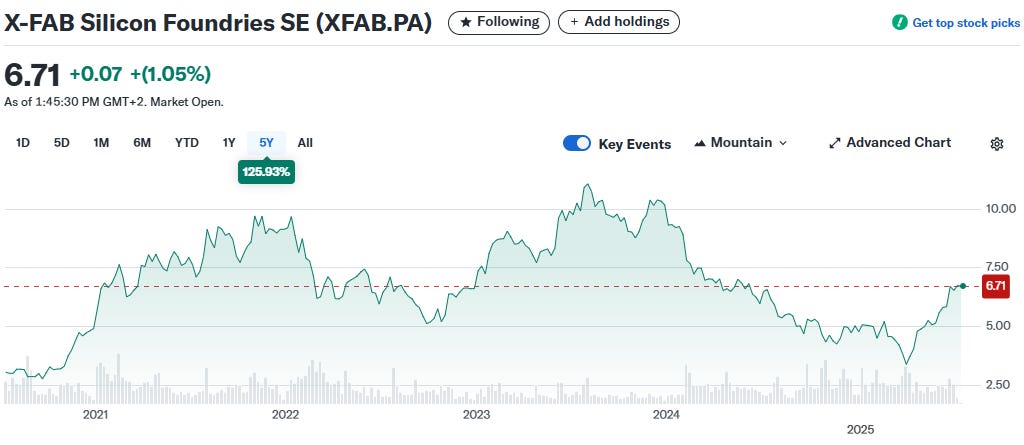Weekly: Why price matters
Weekly 28 2025 + top 4 July
This week
Short news this week from Bellway — very short news. This calm before the storm is normal before every result season.
We also took a look at AMG and Recticel from your selections. The last two, Van de Velde and AAK AB, are scheduled for next week.
And finally, why the top five stocks in July have become a top four. X-Fab, which had been part of the top five since the beginning of this year, is now just not quite cheap enough.
Why Price Matters
On June 26, an article appeared in the Belgian financial newspaper De Tijd titled: The Ideal Stock Portfolio Is Much Larger Than Previously Thought.
One passage in particular caught my attention:
“A second conclusion is that far more than 40 stocks are needed to counter FOMO risk. Of the 87,000 stocks examined, only 162 — or just 0.19 percent of the total — accounted for half of all value created during the period 1985–2023. Only 2.1 percent of all stocks accounted for all the value created, which consists of the extra return above the risk-free rate, harvested through dividends and share price gains.”
That 2.1% generated all the value in the stock market over the measured period. In other words, you have a 1-in-50 chance of picking a stock that belongs to the group of winners. That’s not bad in itself, and if you do your research, your odds probably improve.
But the fact that just 0.19% of stocks account for over half of that created value makes things more difficult. If you really want to outperform, you need to have a few of those stocks in your portfolio. That’s a 1-in-526 chance — a much tougher challenge.
But do we, as investors, really need to go hunting for those rare gems that create all the value? Or is it also possible to earn money from stocks that aren’t among those exceptional businesses?
If we look at Warren Buffett’s essay The Superinvestors of Graham and Doddsville, we see a group of investors — all value investors — who beat the market. Did they all consistently buy from that tiny circle of winning stocks?
No. What they did do was buy businesses below their intrinsic value, and sell them once they reached fair value.
There are two ways to make money with stocks: either your company grows and delivers steady returns year after year, or you buy a stock well below its value and sell it for a profit. In that second scenario, the business itself doesn’t even need to have grown in value.
By not limiting yourself to just those “perfect” stocks, and also looking for undervalued companies, you expand your investment universe — and with it, your chances of outperforming the market.
We also often read about Buffett’s investments in Coca-Cola, See’s Candy, American Express... Businesses he bought long ago that now generate massive dividends. But there were also many other companies that helped build the Berkshire Hathaway empire. Take Blue Chip Stamps, for example. That company no longer exists, but it generated a huge amount of cash for Berkshire, which was then used for further investments.
Examples like Blue Chip — companies that eventually disappear — are more common than those that perform strongly for decades. And yet they were good investments, simply because they were bought at the right price.
To illustrate with our own experience: take X-Fab. We bought this stock for the fund in several rounds in 2020, and sold it in mid-2023. We started buying again last year, and have added more this year.
Our estimated value of X-Fab? In early 2020, it was €12 (as also mentioned in Smart Capital). Today, the estimated value in our selection is €11.5.
Let’s assume, for simplicity, that the company hasn’t really increased in value — or maybe we were a bit too optimistic back in 2020. Our return? In the first round, we achieved a return of 229.4%. On this second round, so far, 45.5%.
Even though the value (in our view) hasn’t increased, we’ve still realized very strong returns.
Here’s how the share price moved:
If we had simply bought and held, our maximum return would have been 126%. After all, we didn’t just buy at the bottom — we had also bought earlier at higher prices.
Buying quality? Absolutely. But only at the right price. And if the price is right, then sometimes a little less quality can still work. Both are ways to protect yourself as an investor. Neither is the one perfect path.
I’d like to end with a quote from a podcast by Ian Cassel (MicroCapClub), loosely translated:
“You start out as a beginner, making mistakes, chasing everything that looks cheap, relying on simple rules of thumb and ratios. But slowly, nuance develops. You learn the difference between cheap and undervalued. You begin to understand what really matters when analyzing management. You discover the limitations of valuation models. And you build up a kind of scar-tissue wisdom — something you can’t just download or rush.”
Ian captures the core idea perfectly: the difference between cheap and undervalued. Not everything that’s cheap is actually undervalued.
Unfortunately, the term “undervalued” is now being thrown around far too loosely — in momentum investing, growth investing, and quality investing alike — to the point where it’s starting to lose its meaning.
And yet, that is exactly what lies at the heart of intelligent investing.



